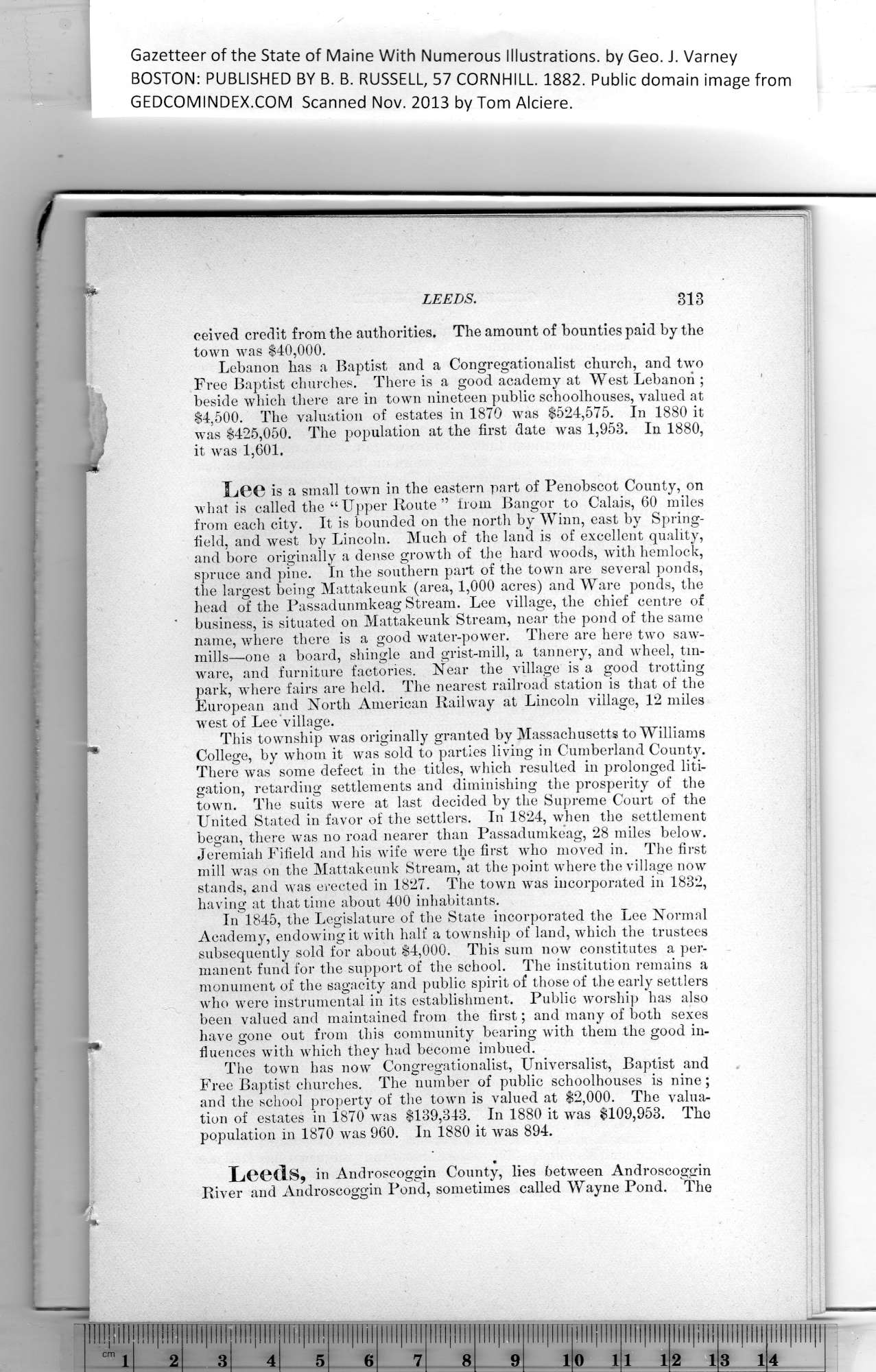|
Gazetteer of the State of Maine With Numerous Illustrations, by Geo. J. Varney
BOSTON: PUBLISHED BY B. B. RUSSELL, 57 CORNHILL. 1882. Public domain image from
LEEDS. 313
ceived credit from the authorities. The amount of bounties paid by the
town was $40,000.
Lebanon has a Baptist and a Congregationalist church, and two
Free Baptist churches. There is a good academy at West Lebanon ;
beside which there are in town nineteen public schoolhouses, valued at
$4,500. The valuation of estates in 1870 was $524,575. In 1880 it
was $425,050. The population at the first date was 1,953. In 1880,
it was 1,601.
Lee is a small town in the eastern part of Penobscot County, on
what is called the “Upper Route ” from Bangor to Calais, 60 miles
from each city. It is bounded on the north by Winn, east by Spring-
field, and west by Lincoln. Much of the land is of excellent quality,
and bore originally a dense growth of the hard woods, with hemlock,
spruce and pine. In the southern part of the town are several ponds,
the largest being Mattakeunk (area, 1,000 acres) and Ware ponds, the
head of the Passadunmkeag Stream. Lee village, the chief centre of
business, is situated on Mattakeunk Stream, near the pond of the same
name, where there is a good water-power. There are here two saw-
mills—one a board, shingle and grist-mill, a tannery, and wheel, tin-
ware, and furniture factories. Near the village is a good trotting
park, where fairs are held. The nearest railroad station is that of the
European and North American Railway at Lincoln village, 12 miles
west of Lee village.
This township was originally granted by Massachusetts to Williams
College, by whom it was sold to parties living in Cumberland County.
There was some defect in the titles, which resulted in prolonged liti-
gation, retarding settlements and diminishing the prosperity of the
town. The suits were at last decided by the Supreme Court of the
United Stated in favor of the settlers. In 1824, when the settlement
began, there was no road nearer than Passadumkeag, 28 miles below.
Jeremiah Fifield and his wife were the first who moved in. The first
mill was on the Mattakeunk Stream, at the point where the village now
stands, and was erected in 1827. The town was incorporated in 1832,
having at that time about 400 inhabitants.
In 1845, the Legislature of the State incorporated the Lee Noi-mal
Academy, endowing it with half a township of land, which the trustees
subsequently sold for about $4,000. This sum now constitutes a per-
manent fund for the support of the school. The institution remains a
monument of the sagacity and public spirit of those of the early settlers
who were instrumental in its establishment. Public worship has also
been valued and maintained from the first; and many of both sexes
have gone out from this community bearing with them the good in-
fluences with which they had become imbued.
The town has now Congregationalist, Universalist, Baptist and
Free Baptist churches. The number of public schoolhouses is nine;
and the school property of the town is valued at $2,000. The valua-
tion of estates in 1870 was $139,343. In 1880 it was $109,953. The
population in 1870 was 960. In 1880 it was 894.
Leeds, in Androscoggin County, lies between Androscoggin
River and Androscoggin Pond, sometimes called Wayne Pond. The
PREVIOUS PAGE ... NEXT PAGE
This page was written in HTML using a program written in Python 3.2
|
